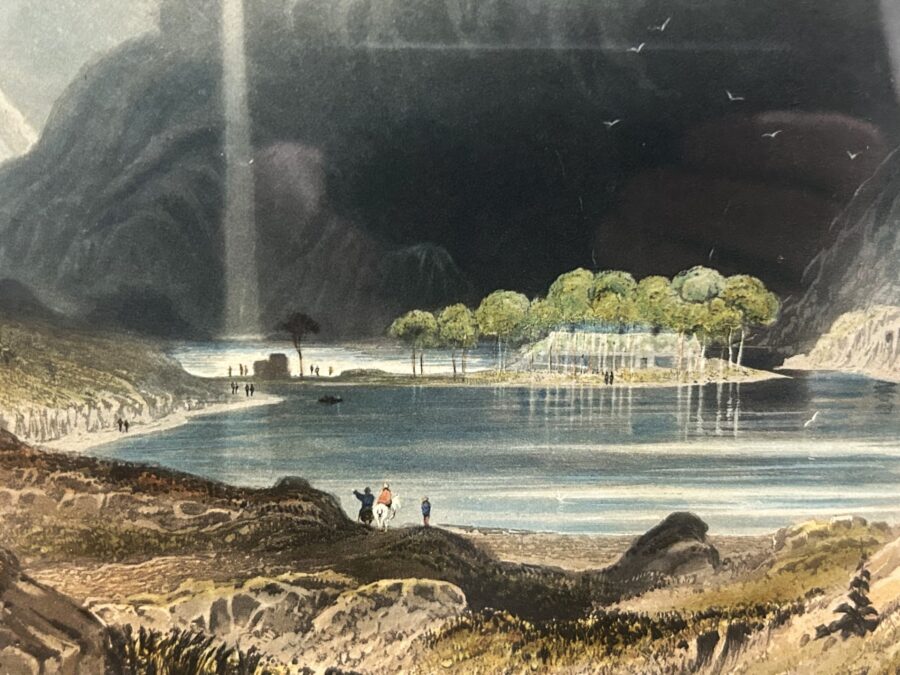
Kieran’s Our City, Our Town Article,
Cork Independent, 1 August 2024
From Source to Sea at the Crawford Art Gallery
One of the last exhibitions before the revamp of the Crawford Art Gallery celebrates the River Lee. The exhibition is entitled From Source to Sea and is on from 22 June to 22 September in the Gibson Galleries at Crawford Art Gallery.
The exhibition following the course of the River Lee, from its origins in the Shehy Mountains and Gougane Barra in the west to its meeting with the Celtic Sea at the mouth of Cork Harbour in the east, has opened at Crawford Art Gallery. Spanning historic and contemporary artworks from the collection, From Source to Sea celebrates the culture of Cork’s mighty Lee and its tributaries.
Artworks from the 1750s through to the present day are featured in the exhibition. Each painting, drawing, print, and sculpture offers a perspective on the river, the stories it has carried and collected, the places and people it has shaped, and the changes it has inevitably borne.
The exhibition features much-loved paintings, ranging from John Butts’ View of Cork from Audley Place (c.1750) and Whipping the Herring out of Town (c.1800) by Nathaniel Grogan, to George Mounsey Wheatley Atkinson’s Paddle Steamer Entering the Port of Cork (1842) and Skellig Night on South Mall (1845) by James Beale. These are joined by the work of artists Sarah Grace Carr, Kate Dobbin, John Fitzgerald, Robert Gibbings, Patrick Hennessy, Seán Keating, Diarmuid Ó Ceallacháin, and George Petrie.
Recent acquisitions by Ita Freeney, Bernadette Kiely, and Donald Teskey offer new contexts, while portraits by Séamus Murphy, Nano Reid, and Eileen Healy recall rich tales from the Lee Valley, including The Tailor and Ansty and the inimitable voice of Cónal Creedon.
In an overall sense, the exhibition encourages the viewer to reflect on the histories and perspectives of the River Lee Valley and to travel back from the city to the source in the Shehy Mountains. Michael Waldron, curator of the exhibition, says: ‘Following our popular exhibitions focusing on Cork city and harbour, it’s been such a pleasure to take a journey along the River Lee itself. I hope visitors will take as much enjoyment in following its course, connecting with the river’s rich history and culture, and maybe even get inspired to take their own stroll at Gougane Barra, Lee Fields, or the Marina”.
It has been over a decade since this column chronicled histories from the Lee Valley and recorded many oral histories from life within it. Some of these stories I have placed up on my website www.corkheritage.ie. At the time, I wrote that the origin of the name Lee is sketchy and legend reputedly attributes the name to an ethnic group known as the Milesians from Spain who reputedly arrived in Ireland several thousand years before the time of St. FinBarre. Legend has it that the Milesians acquired land in Southern Munster, which they named ‘Corca Luighe’ or ‘Cork of the Lee’ from Luighe, the son of Ith who attained the land after the Milesian advent to Ireland.
In addition, the River Lee – An Laoi over the centuries has had many variations in its spelling. In early Christian texts such as the Book of Lismore, it is described as Luae. It has also been written as Lua, Lai, Laoi and the Latin Luvius. An entry in the Annals of the Four Masters in the year 1163 A.D. names the River Sabhrann. However, many scholars agree on the name Lee as the most common name of the River.
The columns from over a decade ago also reflected upon the rich heritage of Gougane Barra. Most notably and grabbing the visitor’s eye at the start of the Crawford Art Gallery exhibition is a hand coloured and beautiful acquatint by Newton Fielding entitled “Gougane Barra Lake with the Hermitage of St Finbarr, County Cork”. It is a copy of George Petrie’s work.
George Petrie (1790-1866) was an important Irish landscape painter of his day. He explored people’s memories along with native Irish cultural traditions as he found them in the historic fabric of old monuments and buildings in the four corners of Ireland. He devoted himself to landscape painting in watercolours.
In 1819 Petrie supplied ninety-six illustrations for Cromwell’s Excursions Through Ireland. He subsequently furnished drawings for several publications, such as the Rev G N Wright’s Guide to Killarney, Guide to Wicklow and Historical Guide to Ancient and Modern Dublin, 1821, as well as Brewer’s Beauties of Ireland, 1825. Petrie’s appreciation of landscape was deeply indebted to William Wordsworth. He also had a constant awareness of the continuity between living folk art and antiquity. Petrie’s work explored the Irish landscape as a cultural echo informed by the lingering memories of native cultural traditions and antiquities.
Petrie’s work as a field officer with the Ordnance Survey of Ireland in the early nineteenth century was, according to art historian Peter Murray, an enormous salvage operation to collect and preserve the remains of Ireland’s native culture and identity. George Petrie’s Gougane Barra(one of two versions) attempts to put the viewer in the heart of the Shehy Mountains. Pilgrims/tourists seem dwarfed by awe-inspiring landscapes and give an increased interest and picturesque aspect to the scene.
Explore and rediscover the Lee Valley with From Source to Sea, whichis on from 22 June to 22 September in the Gibson Galleries at Crawford Art Gallery.
Captions:
1264a. Entrance to From Source to Sea, Crawford Art Gallery (picture: Kiran McCarthy).
1264b. Hand coloured and beautiful acquatint by Newton Fielding entitled “Gougane Barra Lake with the Hermitage of St Finbarr, County Cork”. It is a copy of George Petrie’s work.
